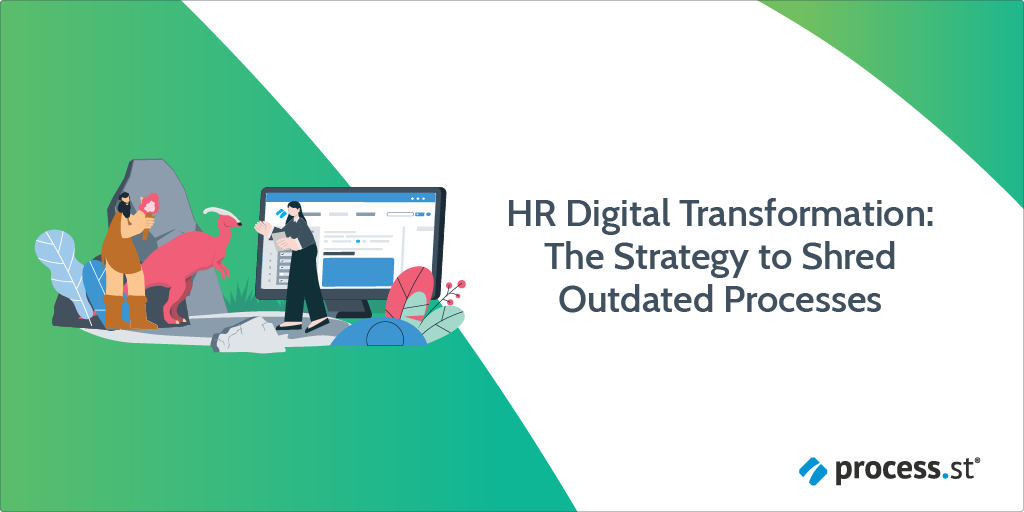
HR digital transformation reminded me of South Korea.
On a recent trip to Seoul, I automated my whole journey. My train tickets, flight tickets, insurance, and apartment key were on my phone. As a result, I felt more engaged on holiday. Which made me wonder, did I ever want to carry paper documents again?
Okay, carrying paper isn’t a difficult task. But as a process, it’s convoluted. Plus, it’s slow. I wasted less time due to automation. By adapting to change, I had a lot more fun.
Adapting to change – technological change – is at the heart of an HR digital transformation. However, it’s not an easy one to get right. It’s often expensive, with HR tech spending up by 57%. But try not to worry. This Process Street post will explain how to do it without breaking the bank:
- What is HR digital transformation?
- HR digital transformation benefits
- HR digital transformation roadmap
- HR digital transformation examples
What is HR digital transformation?
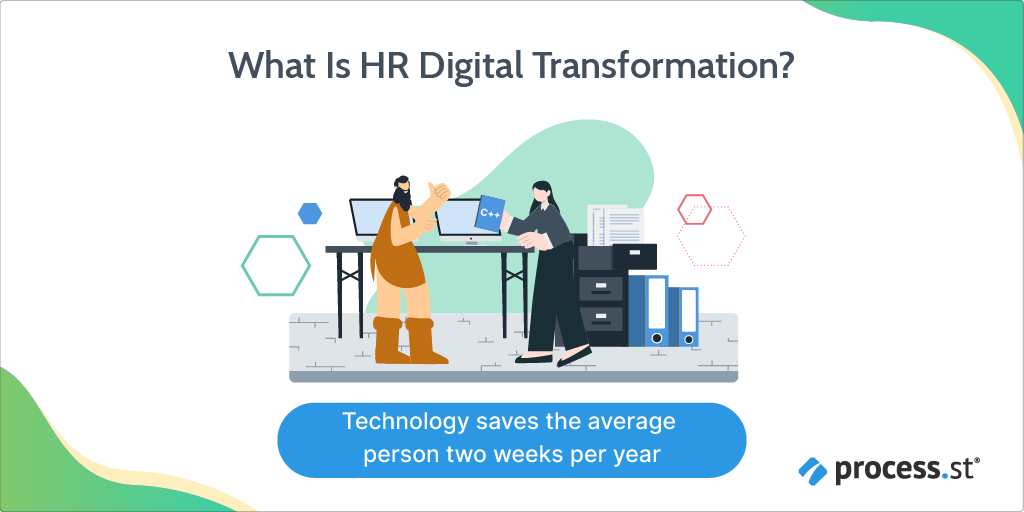
HR digital transformation means replacing old HR processes and optimizing them with automation.
By old processes, we’re talking specifically about your:
- Onboarding
- Recruitment
- Vacation paperwork
You’re looking at taking these recurring processes and making them more accessible and faster. The idea is that HR technology can eliminate tedious manual tasks such as:
- Data entry that steals your time
- Searching filing cabinets for missing documents
- Using Excel checklists when onboarding
You may think it evident that Human Resources can benefit by using new technology. Yet, for a digital transformation to be successful, your whole organization should be involved. Solutions like HR giving everyone a new iPhone may seem the most straightforward answer. However, a solid plan would be cheaper and will bring more benefits.
HR digital transformation benefits
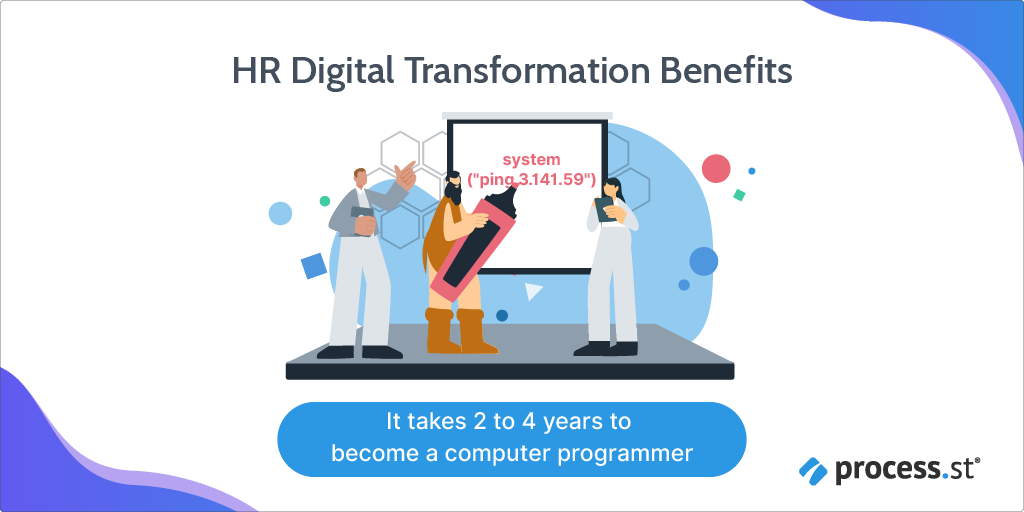
The best three HR digital transformation benefits are:
- Less time wasted
- Easier access to documents
- Better employee engagement.
I’ll sprint through each one to see if they ring a bell with you.
Less time wasted
The benefits of digital transformation reminded me of my first Amazon Kindle. I was working abroad in publishing at the time. The company kept all of its manuscripts on paper. I began digitizing and uploading them to my Kindle. I then read them during bus and airplane journeys. This process saved me hours with what was usually a recurring paper task. It also made the job lightweight.
With the above in mind, it’s also worth considering that paper documents are risky. A flood, fire, break-in, or misplaced documents can spell doom for most organizations. As well as saving time, digitizing protects the user from financial losses.
Easier access to documents
Your documents may remain in one location even if you digitize paperwork. Meaning your data will still be at risk. The other problem you’ll have is that remote workers will not be able to access it. Without resolving this issue, you will struggle to implement automation too.
You’ll also find that more accessible documents will help you route tasks. That way, your teams can work together better. Take a look at how Process Street does this:
Cloud computing has improved teamwork further. For example, knowledge bases are far more common. Having an online knowledge base accessible anywhere in the world is vital. It’s also an essential remote team tool. One that will help your organization adapt to the rise of remote work. It also allows you to increase automation, an integral part of an HR digital transformation.
As Aram Lulla states in an article titled Three Ways Automation Will Transform HR:
“Automation offers benefits beyond payroll and time tracking. Consider the time-intensive, repetitive tasks your HR team routinely performs. Where can you leverage technology solutions to remove redundancy, minimize human error and improve outcomes?”
Better employee engagement
People operations are fertile ground for a digital transformation. The emergence of People Ops also seems to dovetail with the fruition of automation. To increase employee engagement, you’ll be looking to humanize and sync a working environment. One way to do this effectively is to replace outdated paperwork and software. Doing so also improves communication and collaboration.
A process such as onboarding will benefit from being digitized and simplified. For example, employee engagement will thrive by removing tedious tasks rooted in Excel checklists. Having employees use engaging workflows will make their onboarding appealing. Using variables in workflow form fields also reduces data entry. This technology means you’ll have more time to get new hires quickly up to speed.
HR digital transformation roadmap
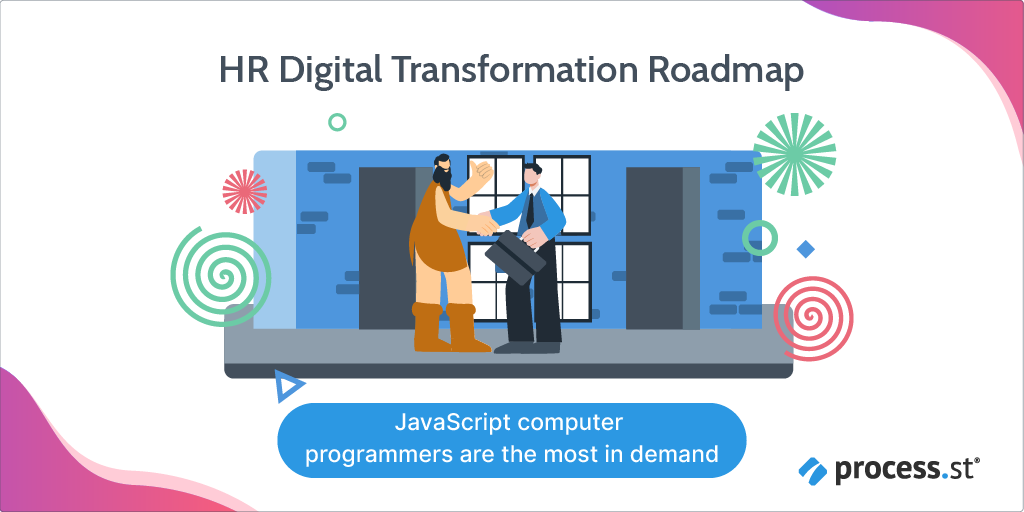
An HR digital transformation needs a roadmap.
“A journey of a thousand miles begins with a single step.“
– Lao Tzu, Tao Te Ching
These are the five steps to accomplishing an HR digital transformation:
- Know the goal you’re going after
- Involve your team
- Investigate your current performance
- Focus on no more than five ideas
- Please keep it simple
Let’s look at each step in more detail:
1. Know the goal you’re going after
You first need to decide what your business wants and needs. Consider if your end goal will be accessible, simple, and financially sustainable. For example, let’s say you’ve decided to support remote employees better. Your resulting goal may be to provide a single effective software that functions without expensive add-ons.
2. Involve your team
Your people are the central part of your HR digital transformation. Without them, it will not have an effect or even survive. You could use anonymous employee surveys to determine where a digital transformation will help the most.
Regarding training your team to use new software, think about Gen Z team members. If you have a multi-generational workforce, ask Gen Z team members to train older employees. When purchasing software, also try to ensure it has good customer support that is easily accessible. You might also consider looking at YouTube demos of a product, such as this Process Street video:
3. Investigate your current performance
Technology constantly refines. The topic of search engine optimization (SEO) often changes. Many daily blogs struggle to follow and stay up to date with SEO trends. Keeping up with change can be a challenge. At Process Street, our product does not require all new computers or a yearly investment in new hardware. We feel this helps our digital service remain affordable.
4. Focus on no more than five ideas
If you decide to automate your recurring tasks, ask yourself how many tools are needed to transform your HR department. As mentioned before, costs can be an issue. It might be that with the right online tool, you won’t need to replace your current computers.
For example, you can access professional software online for a set amount. The monthly price can also be less than the expense of 10 cappuccinos. Be sure to always demo a software product before buying. At Process Street, we decided to reduce testing costs for potential customers. We offer interested customers a free demo and a free account.
Whatever technology you decide to use, we suggest you begin by picking five tasks. These can be daily chores you want to transform digitally, such as:
5. Please keep it simple
HR employees are not usually versed in computer programming languages such as:
In terms of simplicity, a solution might be to choose an accessible product that is no-code. You then do not require computer programmers to be present. The process then remains singular.
It’s also easy for the process to become diluted and fragmented. As we mentioned before, a single solution is best with software. Think quality over quantity.
HR digital transformation examples
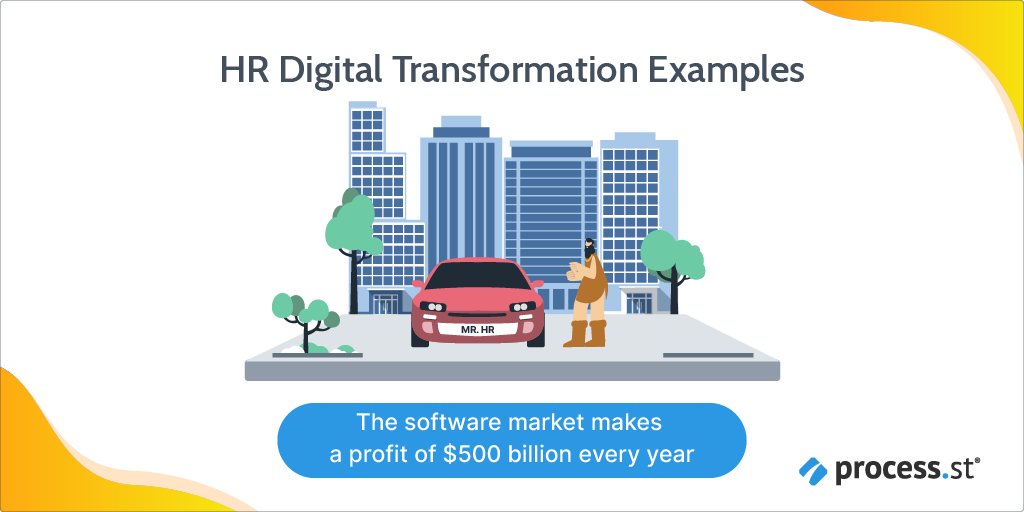
We thought you might be interested in future and existing HR digital transformation examples. The three examples we’ve chosen are:
1. HR chatbots
These computer programs simulate conversations with humans. Often used in recruitment, chatbots answer employee questions 24/7. They can also accomplish some mind-blowing feats.
Paul Phillips reveals in his article titled Chatbots: The New HR Stars:
“One chatbot can handle thousands of conversations at once.”
However, chatbots are not suited – just yet – to tricky legal issues or financial advice.
2. Employee self-service portals
According to a McKinsey study, employees can spend a day every week looking for company information. Companies could lose more time if the information is in one centralized location and on paper. In conjunction with workflows, an online knowledge base can help employees serve themselves quickly and easily.
At Process Street, we have led the way in providing a free-forever knowledge base – called Pages. Within it, company documents are easily accessible. Onboarding is also simpler for all employees. Whether remote or office-based, workflows are quickly accessible. You can also track and monitor onboarding workflows that new hires are using.
A push towards self-management can make remote work succeed for your organization. It’s essential for leading a remote team:
3. Voice search
I once attended a conference and talked with a Microsoft executive. I wanted to know their thoughts on voice search. They explained that no R&D was going into it as no one had figured out how to monetize it. Amazon’s Alexa has solved that problem and made money by suggesting paid services.
If HR moves into this technology, we could see employees quickly having their questions answered. These might be inquiries such as:
- Where can I find the unlimited PTO policy?
- Can I get copies of my payslips from five years ago?
- Do volunteer opportunities exist in the organization?
All of the above once again removes the need for extensive paperwork. The Department of Homeland Security spent nearly 200 million hours on paperwork in one year. With this in mind, it seems that adapting to new tech can save money.
Seoul of the digital nomad

You may remember I mentioned that I automated my journey to South Korea. I forgot to mention that online digital documents didn’t cost me a cent. It seems that being adaptable when traveling needn’t be expensive.
“It is not the strongest of the species that survives, not the most intelligent that survives. It is the one that is the most adaptable to change.”
– Charles Darwin, The Origin of Species
With adaptability in mind, the best HR digital transformation you can aim for is:
- Easily accessible
- Financially sustainable
- Simple to maintain
Let us know if you’re considering an HR digital transformation in your workplace. Please give us your thoughts on the topic in the comments box below!







Mark Jones
Mark Jones is a content writer at Process Street.